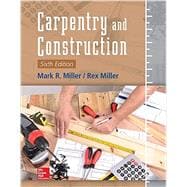This fully updated, hands-on guide covers every stage of construction and remodeling
This step-by-step guide serves both as a field reference for construction professionals and as a textbook for students and apprentice carpenters going through the training and certification process. The book clearly demonstrates each phase of construction—from selecting tools and materials to pouring foundations and finishing interiors. This how-to handbook also covers remodeling, additions, and repairs.
Carpentry and Construction, Sixth Edition lays out each topic in a practical, application-driven manner and features more than 1,500 photographs and illustrations. You will get information on the latest tools and equipment, new materials for flooring, roofing, and plumbing, environmentally safe insulation, and wiring methods for home electronics. A brand-new chapter covers painting methods.
- Written by a pair of construction experts and experienced authors
- Updated images throughout plus 16 pages of full-color photos
- End-of-chapter questions review important concepts and techniques








